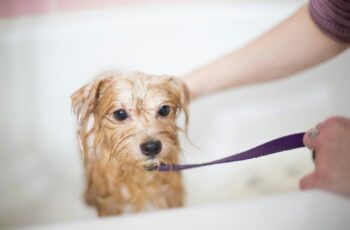Potty training a young dog is always a challenge for pet parents. Your puppy seems to have zero bladder control and isn’t fussy about where he relieves himself. It’s a messy business!
However, potty pad training puppies needn’t be as stressful if you know how to potty train a puppy on pads. Training pads can also be used as a permanent arrangement for small, apartment-living dogs.
Read our guide on how to train a puppy to use a pee pad for full instructions and top tips!
Are Puppy Pads The Right Choice For Your Puppy?
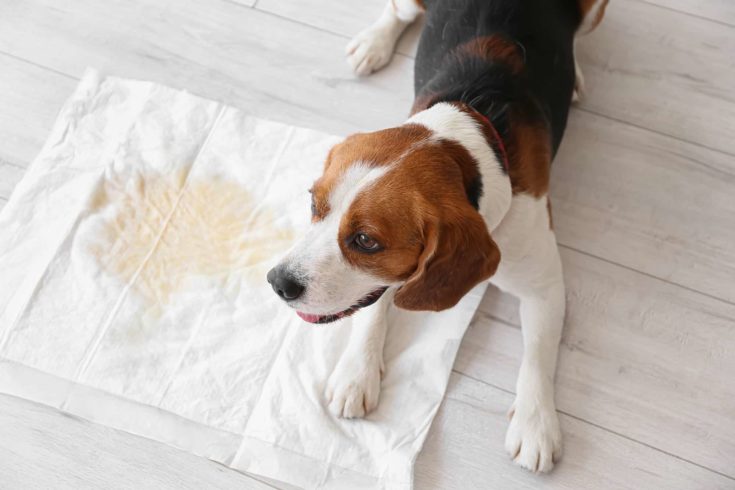
Although most dog owners prefer to teach their dogs to relieve themselves at a designated potty spot outside, some pet parents take the puppy training pad route.
Of course, if you decide to use potty pads as a temporary solution for a new puppy, you will eventually need to teach your pup not to relieve himself inside but to go outside instead.
So, are puppy training pads the right choice for you and your puppy?
You Have A Small Dog
Small dog breeds create correspondingly small messes, and that makes using potty pads a good option. Also, little dogs have small bladders, so holding on for long periods of time is not an option. For that reason, traditional outdoor potty training can be extremely challenging.
It’s Cold Outside!
If you live in a region where the winters are very cold, using puppy pads is the perfect solution for puppies that hate the cold.
Apartment Dwellers
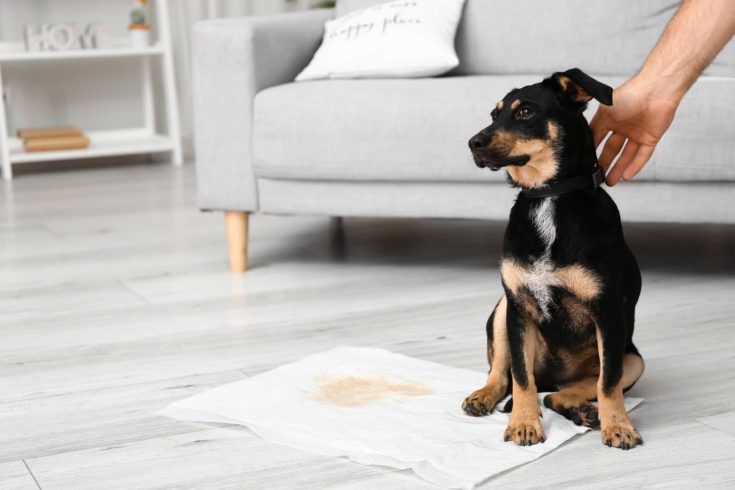
If you live in an apartment, it’s not always practical to dash outside with your puppy for a potty break, and not all apartment buildings have rooftop potty spots. In that case, puppy pads can be a good solution.
People With Limited Mobility
Seniors and those with limited mobility can find using potty pads a good option, saving them from having to go outside five or six times every day to take their dog for a potty stop.
However, a dog walker will still be required to give the dog the exercise it needs.
Senior Dogs
If you have a senior dog, it can be tricky to get your pup outside in time when he needs to go.
When my elderly dog started to struggle with arthritis and bladder control, it wasn’t always easy to get her outside in time. I found puppy pads to be a godsend, especially at nighttime.
Shy, Nervous Dogs
Sometimes, a very nervous puppy or dog will be too afraid to relieve himself outside, especially if there are loud noises, passing traffic, or other dogs around. In that case, puppy pads can be a useful solution to the problem.
What Are The Different Kinds Of Puppy Pads?
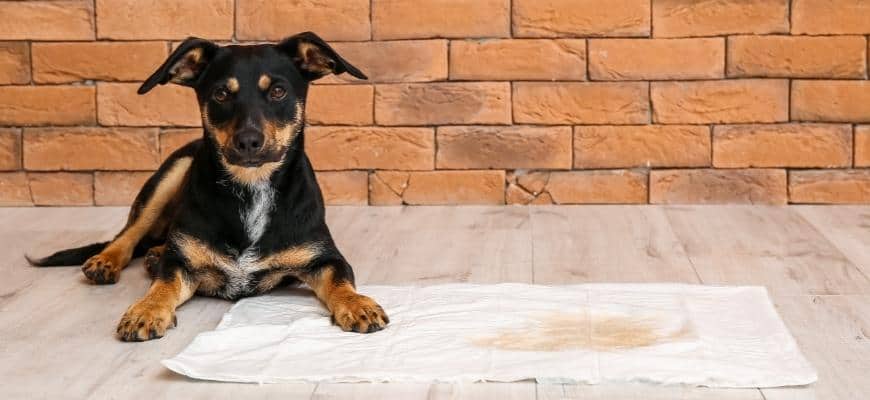
Years ago, puppy training pads consisted of a pile of newspaper on your kitchen floor, but puppy pads have come a long way since then.
Now, there are several options to choose from:
Fabric Training Pads
The most popular puppy pads on the market are made from layers of spongey material that soaks up liquid and catches solid waste. These pads are leak-proof, mess-free, and simple to use.
Litter Boxes
If you have a small dog, a litter box might be a good choice for you. Fill the box with recycled paper pellets, as you would with a kitty litter tray, and clean the box out daily.
Grass Pee Pads
You can choose puppy pee pads made from fake or real grass! These pads are an excellent option for you if you want to move your puppy from indoor puppy pads to outdoors.
Grass pads teach your puppy that going on the grass is correct behavior and play on your pup’s natural instincts, too.
How To Potty Train A Puppy To Go On Pee Pads
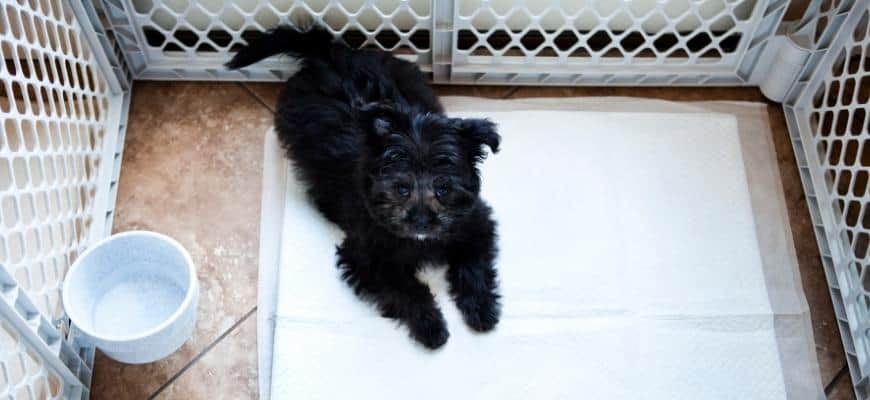
Once you’ve chosen your ideal potty training pads, you can start the potty training process.
1. Choose A Place For The Potty Pad
Choose a suitable place for your puppy’s potty pads to “live.”
Ideally, that spot should be in a quiet place where your puppy has privacy and ideally over hard flooring. The bathroom is a popular location that many pet parents choose.
Avoid the kitchen and areas where you’ll have guests for obvious reasons. In addition, the bathroom is usually a small room, making it easier to confine your puppy there.
If you decide to use your bathroom, take care to put all your cleaning products and toiletries well out of your puppy’s reach.
2. Confine Your Puppy
Dogs are naturally clean creatures that won’t choose to soil their sleeping area. So, using a small space for your dog to spend time in can help potty training be successful by teaching your dog to hold it. A crate is an ideal solution for that.
Take the time to crate train your puppy properly to ensure successful potty training. If you want to learn more about crate training your puppy, you can read our article dedicated to this topic.
When you take your puppy out of his crate, take him straight to the puppy pad. At first, that will need to happen every couple of hours. As the puppy grows, he should be able to wait longer between potty stops so that you can increase the time between visits to the puppy pad.
When your puppy relieves himself in the right place, be sure to give him high-value treats and lots of praise.
How Often Do Puppies Need To Go?
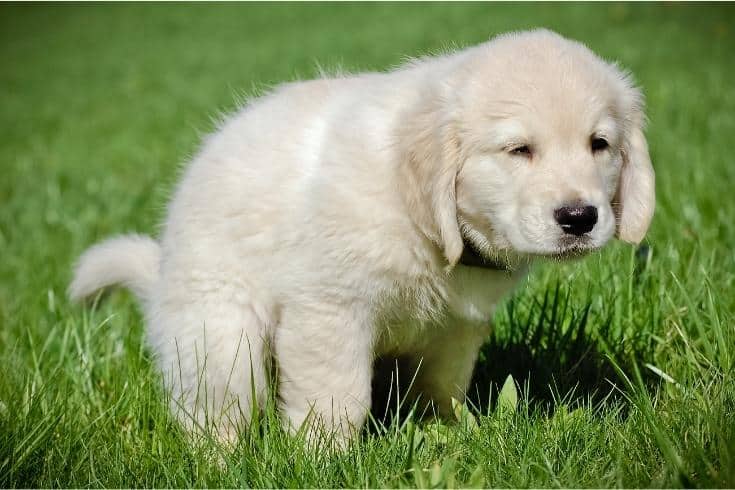
Puppies need frequent potty breaks. A pup of two to three months of age generally needs to pee every 2 hours. After that, you need to add an hour for the puppy’s age in months. For example, a six-month-old dog should be able to wait for up to 6 hours.
Never leave a dog without bathroom breaks for more than 8 hours.
Throughout the initial potty training process, do not leave your puppy alone and unattended. That’s vital since you must be there to reward and praise your puppy for good toilet behavior.
We know that it’s a pain having to wait around hoping to catch your puppy pooping or peeing on an indoor potty pad. However, that’s essential if you want to train your dog effectively during the first stages of potty training.
3. Provide Your Puppy With More Space
Once your puppy’s potty training is well underway, you can graduate to using a larger space.
So, rather than leaving your puppy in his crate, you can create a small area within your home where your puppy can roam around unsupervised. Puppy playpens, baby gates, or simply closing the room’s door all work as effective potty training tools.
Your puppy won’t soil his toys, bed, or water bowl, so make a space that allows just enough room for those items and a puppy pad. Again, if you see your puppy using the pads, praise her and provide plenty of treats.
Clean up messes right away so that your puppy isn’t tempted to eat his own feces.
4. Increase The Space
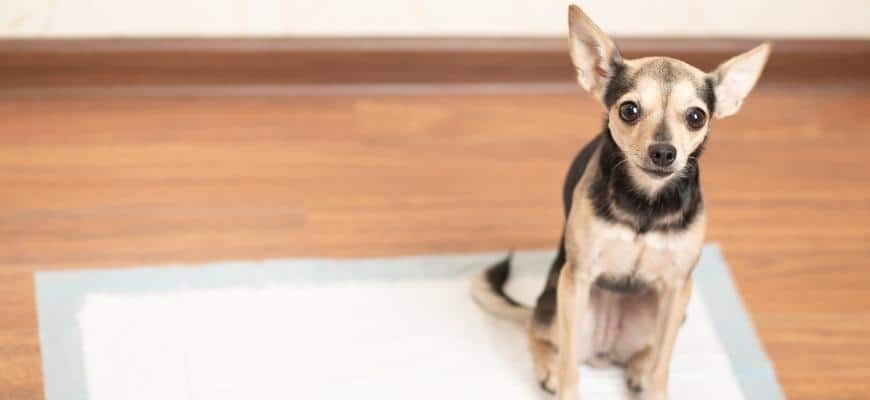
Now that your puppy has learned how to use his puppy pad in an enclosed area, you can give him more space.
Eventually, your puppy can have the run of whatever rooms you want him to access in your home without fear of him having an accident.
Dealing With Potty Accidents
Unfortunately, potty accidents are almost guaranteed to happen. That’s quite normal and just goes with the territory of owning a puppy!
Never scold or punish your puppy if he has an accident.
Your puppy is not being naughty or trying to annoy you. He simply needed to go, and you weren’t around to let him out or guide him to his puppy pad.
Scolding your puppy can confuse him and send the message that he can’t relieve himself when you’re watching him. Puppies have short memories, and there’s no point scolding your pup after the fact. Your baby dog simply won’t understand what he’s done to annoy you.
So, if you discover an accident, take your puppy to his training pad. If he relieves himself, reward and praise him enthusiastically.
FAQs
In this section of our guide, we answer some of the most frequently asked questions on common training mistakes and on how to train a puppy to use a pee pad.
How do you attract a dog to pee on a pad?
Persuading your puppy to go on a pee pad is a matter of perseverance. Use positive training methods to teach your little furry friend that his puppy pad is the only place he should use for toilet breaks.
Watch for signs that your puppy needs to go, such as circling, sniffing, or scratching at the floor, and be sure to pick up your puppy and take him to his training pad right away.
As soon as your puppy relieves himself on the disposable training pad, reward him with super high-value training treats and praise him verbally. Once your puppy realizes that he will receive your approval and a tasty treat, he will be keen to use his training pad!
How long does it take to potty train a puppy on pee pads?
The goal of potty training is to teach your puppy to relieve himself on an indoor puppy pad before moving on to outdoor training.
It usually takes between four and six months for pee pad training to be successfully completed. That said, some dogs might learn quicker than that, whereas others can take up to one year to be fully potty pad trained.
Do puppy pads help potty train?
Generally, pee pad training is helpful when potty training your dog, especially if you live in an apartment where it’s not easy or quick to get your puppy outside when he needs to go. In addition, you can typically progress to outdoor training once the puppy pad training stage has been completed.
However, there are a few downsides to using puppy pads.
- Puppies can become used to using pads, making it less likely the pup will become completely, reliably potty trained.
- Some puppies confuse the pad with your carpets and rugs, leading to messy accidents!
- Puppy pads can get your dog out of the habit of going outside for a toilet break.
That said, grass litter box liners can help a dog to understand that he should relieve himself in an outdoor grassy space rather than indoors.
How do I use puppy pads and outdoor potty training together?
The transition from the puppy pad training stage to full outdoor toilet breaks should be gradual. If your indoor potty area is located some distance from an outside door, you’ll need to relocate the pads nearer to the outside door.
Once your puppy can wait for a few hours, you can move the pee pad next to the door. Finally, move the pad outside to your pup’s designated outdoor toilet place. At that time, you can dispense with the pee pads altogether.
How many puppy pads should I put down?
You should generally use four puppy pads placed in a large square. That gives your puppy plenty of space to relieve himself without spilling onto the floor area surrounding the pads. Gradually reduce the number of pads to teach your puppy to use a smaller area as a toilet spot.
That said, tiny breed dogs and small puppies don’t need as many puppy pads, whereas large breeds might need more.
At night, use the same number of pads as you would during the daytime.
Final Thoughts
I hope you enjoyed our guide on how to potty train a puppy to go on pee pads. If you did, please take a moment to share the article!
Puppy pads can be a useful house training aid for pet parents, especially if you live in an apartment or in a climate where the winter months are extremely cold. Use a crate or small, confined area initially to show your puppy where he’s allowed to go potty. Gradually make the area larger and give your furry friend more freedom until you can trust him completely to use the pads or ask to go outside.
You can typically wean your puppy away from puppy pads and train him to go outside within around two weeks.
Do you use puppy pads to potty train your puppy? Tell us how you’re doing in the comments box below.


